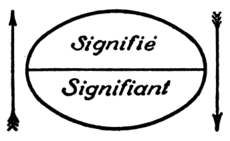Sign (linguistic)
A linguistic sign refers to the connection between an idea or object and an image, sound, or word that identifies it. This term was created by Ferdinand de Saussure, a linguist and professor in the nineteenth century[1]. The study of signs and other symbols is known as semiotics [2]. An important note about a sign is that an individual cannot create a sign of their own by coining a new name for something; a community of some kind must associate the thought and word together for a sign to truly exist.
A sign is composed of the signified, the value or object that is represented, and signifier, the image or word that represents it. Saussure theorized that an idea could not exist without the words to describe it, and therefore the signified and signified are inseparable. In the translated version of Course in General Linguistics, a compilation of notes taken on Saussure's lectures, Saussure uses a sheet of paper as a representation of the sign: there are two sides to the sheet of paper, just as there is both a signifier and a signified, but together they form one sheet of paper, representative of the sign as a whole[3].
References
- ↑ Saussure, Ferdinand de (1857–1913) written by David Holdcroft in 1998, published on Routledge Encyclopedia of Philosophy
- ↑ Semiotics for Beginners written by Daniel Chandler and published to Portland State University's website
- ↑ An Exerpt from Course In General Linguistics by Ferdinand de Saussure, published by the University of Missouri--St. Louis (Does not unfortunately contain the section referencing the sheet of paper)
